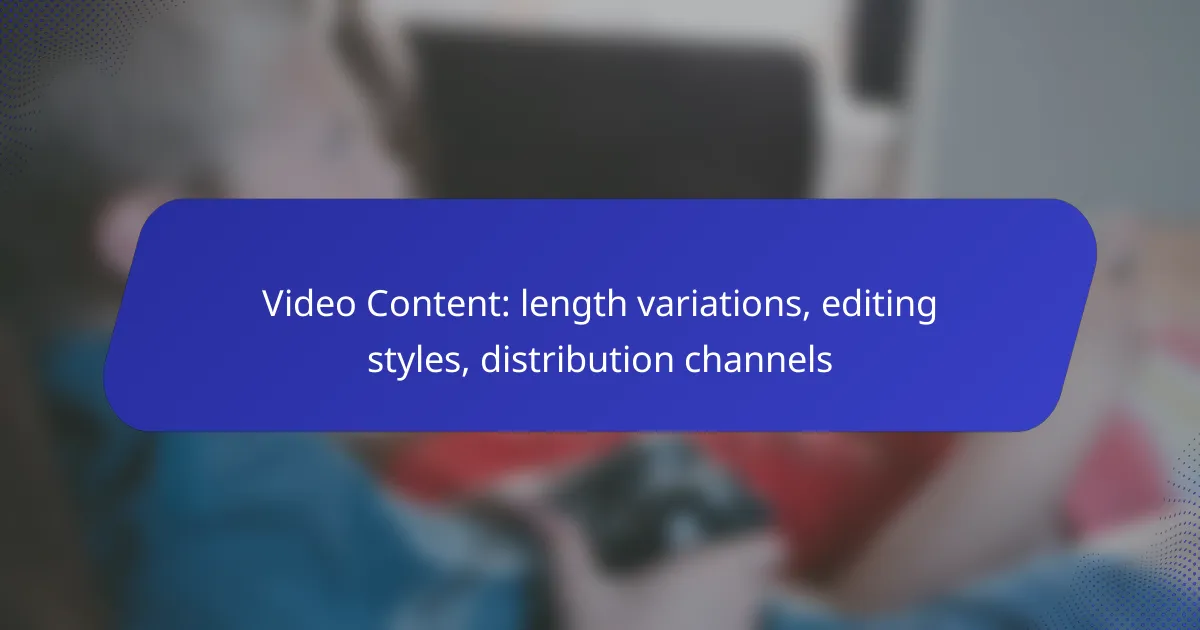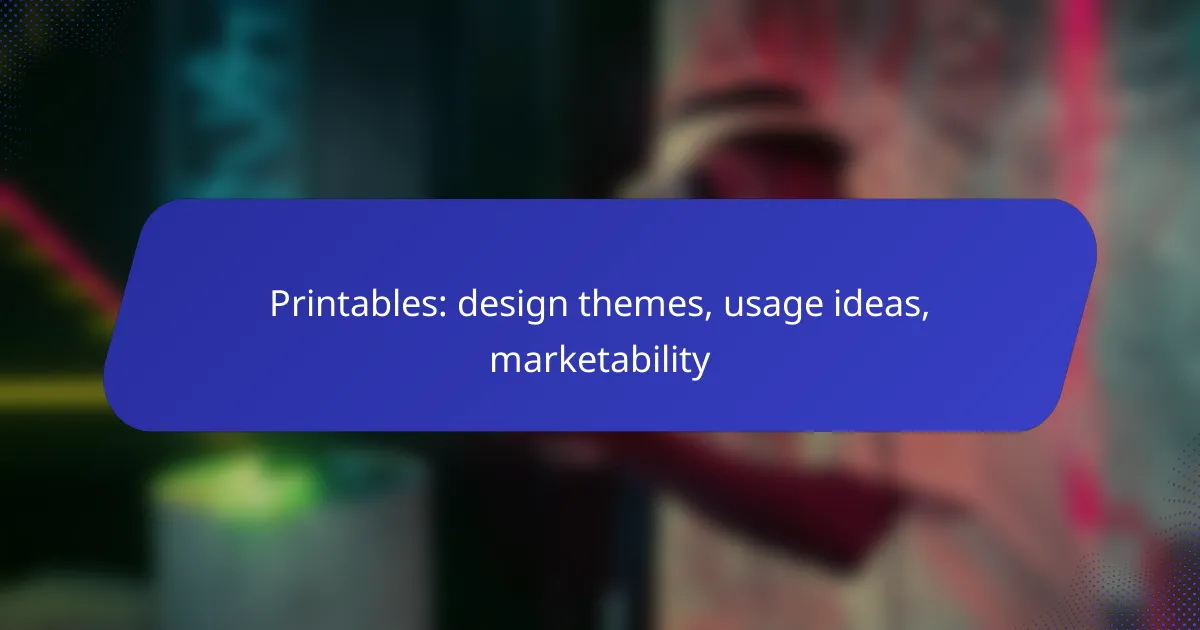Video content has become a crucial element in digital marketing, with optimal lengths varying by platform; short-form videos thrive on social media, while longer formats are ideal for YouTube. Employing diverse editing styles, such as montage and jump cuts, can enhance storytelling and viewer engagement. To maximize reach, it’s essential to choose the right distribution channels that resonate with your target audience, leveraging social media and video hosting sites effectively.
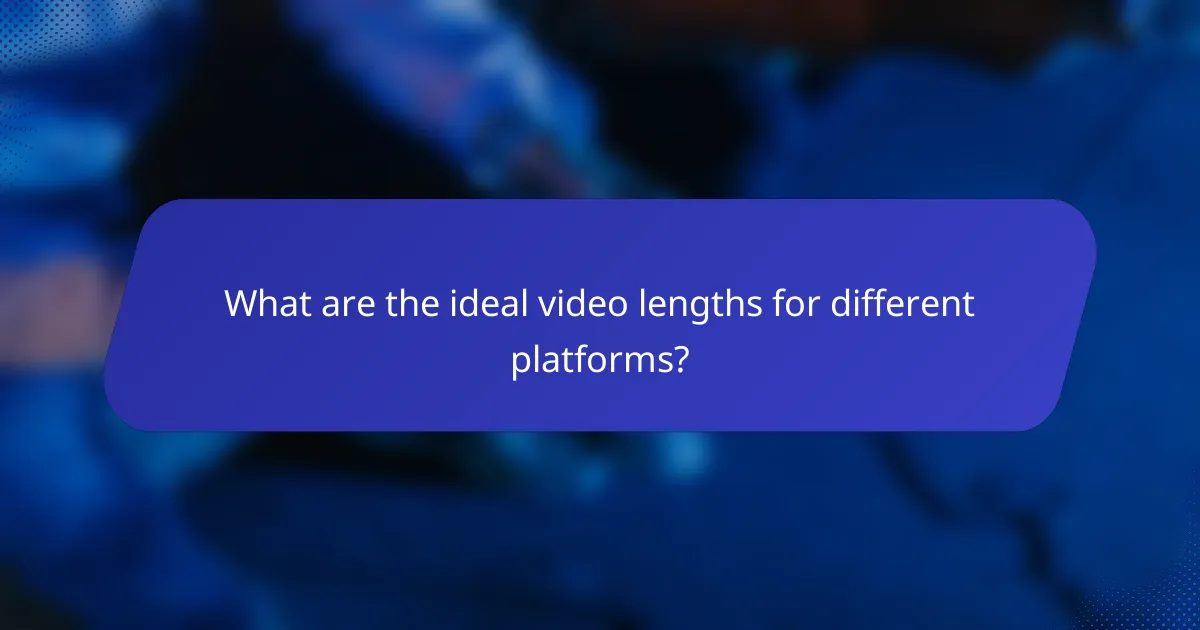
What are the ideal video lengths for different platforms?
The ideal video lengths vary by platform, with short-form content typically performing best on social media, while longer videos are more suited for platforms like YouTube. Understanding these preferences can enhance viewer engagement and retention.
Short-form videos (under 60 seconds)
Short-form videos, typically lasting under 60 seconds, are ideal for platforms like TikTok and Instagram Reels. These quick clips cater to audiences with shorter attention spans, making them perfect for snappy, engaging content.
To maximize impact, focus on delivering a clear message or entertaining hook right from the start. Use eye-catching visuals and concise storytelling to capture viewer interest quickly.
Medium-length videos (1-5 minutes)
Medium-length videos, ranging from 1 to 5 minutes, work well on platforms like Facebook and Instagram. This duration allows for more in-depth storytelling while still being digestible for viewers.
Consider using this length for tutorials, product demos, or quick news updates. Ensure that the content remains engaging throughout, as viewer drop-off can increase if the pacing slows.
Long-form videos (over 10 minutes)
Long-form videos, which exceed 10 minutes, are best suited for platforms like YouTube, where audiences expect detailed content. This format is ideal for in-depth tutorials, documentaries, or comprehensive reviews.
When creating long-form content, structure your video with clear sections to maintain viewer interest. Use engaging visuals and storytelling techniques to keep the audience invested throughout the entire duration.
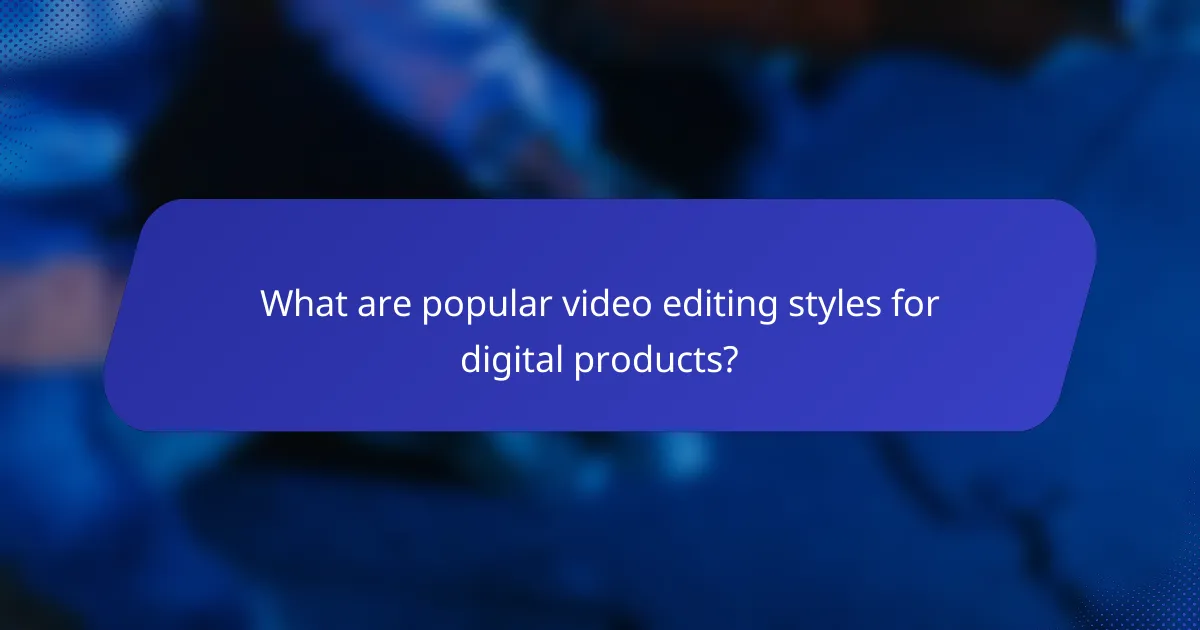
What are popular video editing styles for digital products?
Popular video editing styles for digital products include techniques that enhance storytelling and engagement. These styles, such as montage, cutaway, and jump cut editing, each serve distinct purposes and can significantly impact the viewer’s experience.
Montage editing
Montage editing involves assembling a series of short clips to convey a narrative or theme quickly. This technique is effective for summarizing events, showcasing transformations, or illustrating the passage of time. For example, a montage might depict a character’s journey through a series of rapid scenes, creating a sense of progression.
When using montage editing, consider the pacing and rhythm of the clips. Aim for a balance that maintains viewer interest without overwhelming them. A common pitfall is including too many clips, which can dilute the message. Instead, focus on key moments that resonate with the audience.
Cutaway editing
Cutaway editing involves inserting a shot that interrupts the main action to provide additional context or information. This style is useful for highlighting reactions, adding commentary, or showcasing related visuals. For instance, during an interview, a cutaway might show the interviewee’s subject matter to reinforce their points.
To effectively use cutaway editing, ensure that the inserted footage is relevant and enhances the narrative. Avoid abrupt transitions that can confuse viewers. Instead, use smooth cuts that maintain the flow of the main action, allowing the audience to absorb the additional information seamlessly.
Jump cut editing
Jump cut editing is characterized by the removal of sections of footage to create a jarring effect, often used to condense time or emphasize a point. This style can add energy and urgency to a video, making it popular in vlogs and social media content. For example, a jump cut might eliminate pauses in a speaker’s dialogue, keeping the pace lively.
While jump cuts can be engaging, overusing them may lead to viewer fatigue. It’s essential to strike a balance between maintaining momentum and ensuring clarity. Use jump cuts strategically to highlight key moments or reactions, and consider the overall narrative flow to avoid disorienting the audience.

How to distribute video content effectively in the UK?
To distribute video content effectively in the UK, focus on selecting the right platforms that align with your target audience and content type. Utilize social media, video hosting sites, and email marketing to maximize reach and engagement.
Social media platforms (Instagram, TikTok)
Social media platforms like Instagram and TikTok are ideal for short, engaging video content. These platforms favor visually appealing and concise videos, often ranging from a few seconds to a couple of minutes.
When distributing on these channels, consider using trending hashtags and challenges to increase visibility. Regularly posting content can also help maintain audience interest and engagement.
Video hosting sites (YouTube, Vimeo)
Video hosting sites such as YouTube and Vimeo are suitable for longer, more detailed content. YouTube allows videos of various lengths, making it a versatile choice for tutorials, vlogs, and documentaries.
Ensure your videos are optimized with relevant titles, descriptions, and tags to improve searchability. Engaging thumbnails and calls to action can also enhance viewer retention and interaction.
Email marketing campaigns
Email marketing can effectively distribute video content directly to your audience. Including videos in emails can increase click-through rates, making your messages more engaging.
Keep videos short and relevant, ideally under two minutes, to maintain viewer interest. Use compelling subject lines and clear calls to action to encourage recipients to watch your videos.
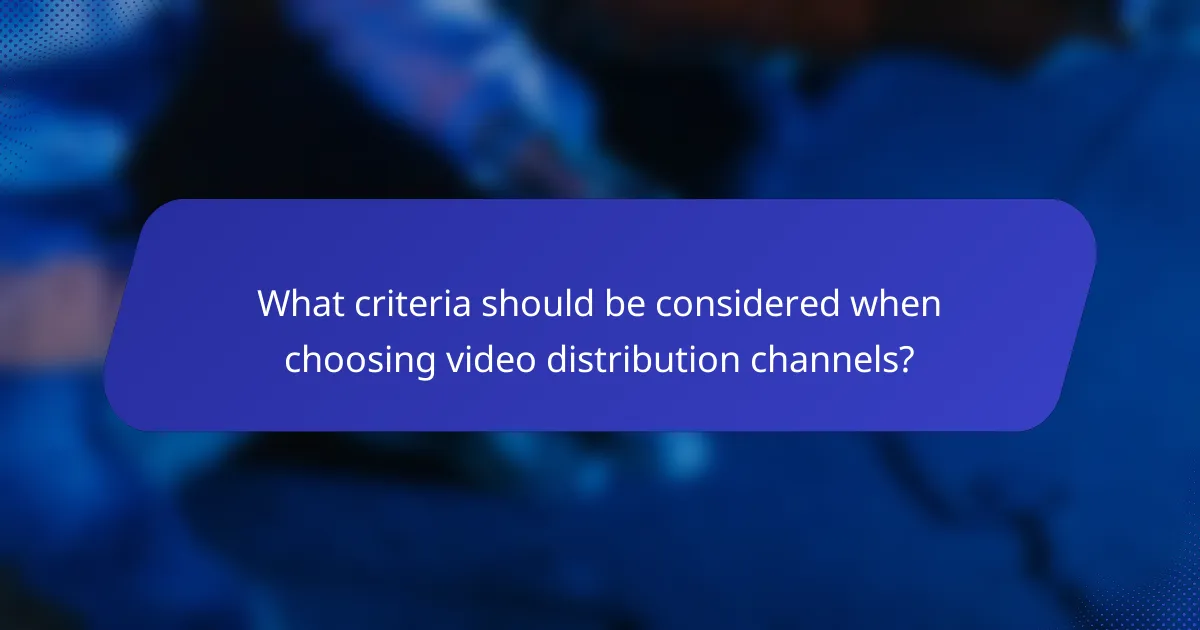
What criteria should be considered when choosing video distribution channels?
When selecting video distribution channels, consider factors such as your target audience, the type of content you are producing, and how you plan to measure engagement. These criteria will help ensure that your videos reach the right viewers effectively and efficiently.
Target audience demographics
Understanding your target audience demographics is crucial for effective video distribution. Factors such as age, gender, location, and interests can influence which channels will be most effective. For example, younger audiences may prefer platforms like TikTok or Instagram, while older viewers might engage more with Facebook or YouTube.
To identify the best channels, conduct research on where your audience spends their time online. Use analytics tools to gather data on viewer preferences and behaviors, which can guide your distribution strategy.
Content type and format
The type and format of your video content significantly impact your choice of distribution channels. Short, engaging clips may perform well on social media platforms, while longer, in-depth videos are better suited for YouTube or Vimeo. Consider the nature of your content—educational, entertaining, or promotional—and align it with the appropriate channels.
For instance, if you are producing tutorials or webinars, platforms that support longer formats and detailed descriptions, like YouTube, are ideal. Conversely, for quick promotional videos, platforms like Instagram Stories or Snapchat are more effective.
Engagement metrics
Engagement metrics are essential for evaluating the success of your video distribution strategy. Metrics such as view counts, likes, shares, and comments provide insight into how well your content resonates with viewers. Monitoring these metrics can help you refine your approach and improve future video campaigns.
Establish key performance indicators (KPIs) based on your goals. For example, if brand awareness is a priority, focus on reach and impressions. If driving conversions is the aim, track click-through rates and viewer retention. Regularly analyze these metrics to adjust your distribution tactics accordingly.
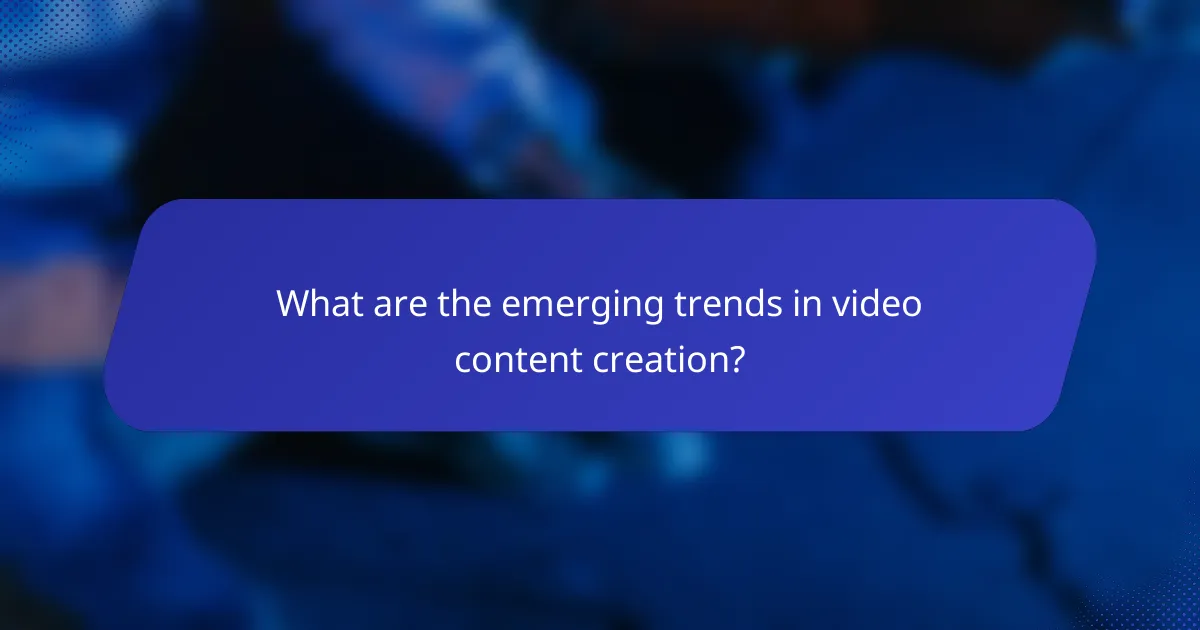
What are the emerging trends in video content creation?
Emerging trends in video content creation include interactive experiences, live streaming events, and augmented reality integration. These trends are reshaping how audiences engage with video, offering more immersive and dynamic ways to consume content.
Interactive video experiences
Interactive video experiences allow viewers to engage with content actively rather than passively watching. This can include clickable elements, branching storylines, or viewer choices that influence the narrative. For example, platforms like YouTube and Vimeo now offer features that let creators add interactive elements to their videos.
When creating interactive videos, consider the user experience carefully. Ensure that interactions enhance the story rather than distract from it. A common pitfall is overloading the video with too many choices, which can overwhelm viewers.
Live streaming events
Live streaming events have gained popularity as they provide real-time interaction between creators and their audience. This format is ideal for product launches, Q&A sessions, or virtual events, allowing for immediate feedback and engagement. Platforms like Twitch and Facebook Live facilitate these interactions effectively.
To maximize the impact of live streams, promote them in advance and engage with viewers during the event. Avoid technical issues by testing your equipment and internet connection beforehand. Remember, consistency in scheduling can help build a loyal audience.
Augmented reality integration
Augmented reality (AR) integration in video content enhances the viewing experience by overlaying digital elements onto the real world. This trend is particularly popular in marketing and gaming, where brands use AR to create immersive campaigns. For instance, Snapchat and Instagram offer filters that allow users to interact with AR content directly.
When incorporating AR, focus on creating seamless experiences that add value to the content. Avoid overly complex implementations that may confuse users. Testing AR features with a small audience before full deployment can help identify potential issues and improve user engagement.
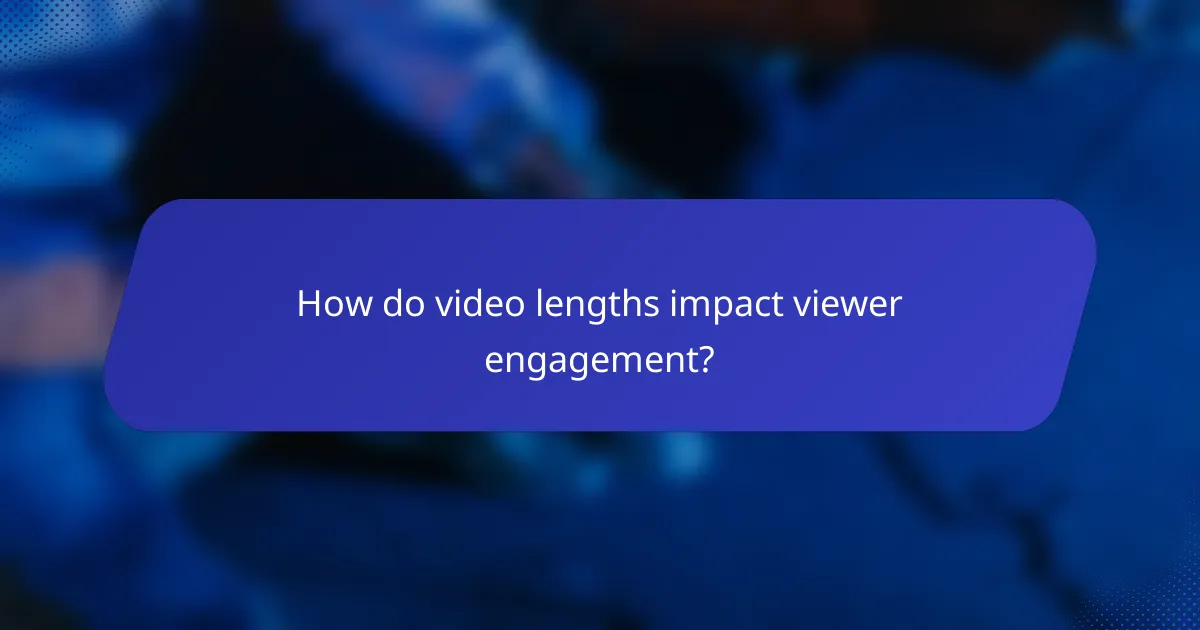
How do video lengths impact viewer engagement?
Video lengths significantly influence viewer engagement, with shorter videos often retaining attention better while longer videos can provide more in-depth information. Understanding the balance between these lengths is crucial for effective content strategy.
Shorter videos increase retention
Shorter videos, typically ranging from 30 seconds to 2 minutes, tend to keep viewers engaged for longer periods. This is particularly effective for platforms like TikTok and Instagram, where quick, digestible content thrives.
To maximize retention, focus on delivering your message quickly and clearly. Use attention-grabbing visuals and concise storytelling to maintain interest. Avoid unnecessary filler content that could lead to viewer drop-off.
Longer videos enhance depth of content
Longer videos, which can range from 5 to 30 minutes or more, allow for a deeper exploration of topics. These formats are well-suited for platforms like YouTube, where audiences often seek comprehensive information.
When creating longer content, ensure that it is well-structured and engaging throughout. Break the content into segments with clear transitions to maintain viewer interest. Consider using chapters or timestamps to help viewers navigate the material effectively.
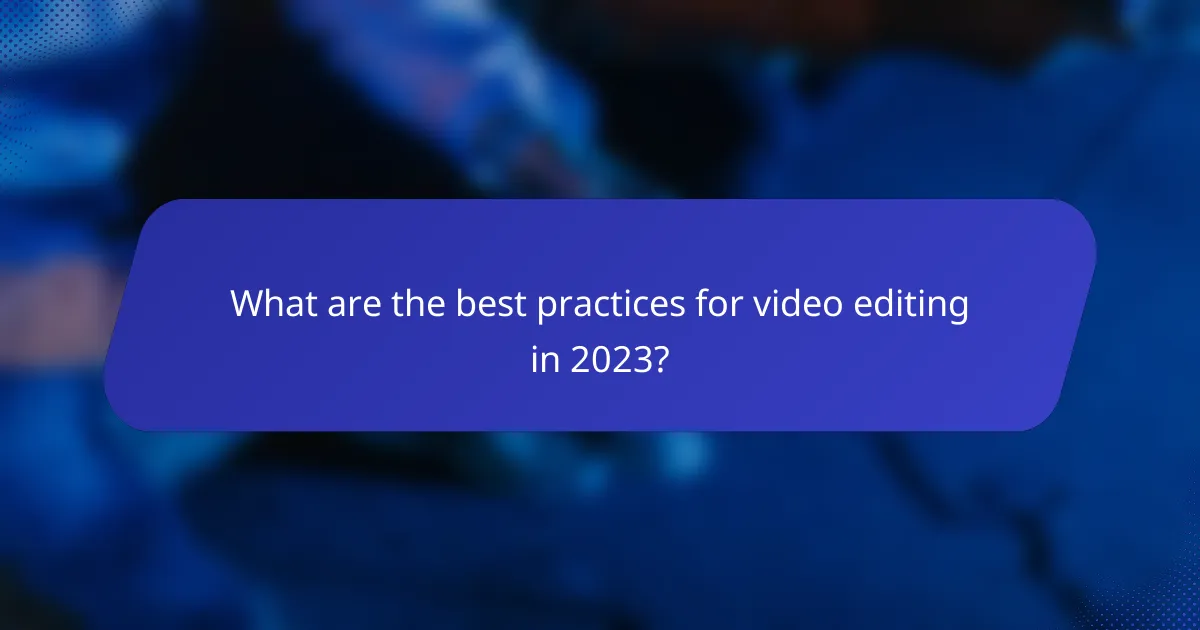
What are the best practices for video editing in 2023?
In 2023, effective video editing focuses on clarity, engagement, and adaptability across platforms. Prioritizing concise storytelling, optimizing for various distribution channels, and utilizing modern editing techniques are essential for capturing audience attention.
Video Length Variations
Video length can significantly impact viewer retention and engagement. For social media platforms, aim for short videos, typically under 60 seconds, to cater to users’ limited attention spans. In contrast, longer formats, such as tutorials or documentaries, can range from 5 to 20 minutes, allowing for deeper exploration of topics.
Consider the platform when determining video length. For instance, YouTube supports longer content, while TikTok and Instagram favor brevity. Tailoring your video length to the platform’s audience expectations can enhance reach and effectiveness.
Editing Styles
Choosing the right editing style is crucial for conveying your message effectively. Popular styles in 2023 include jump cuts for fast-paced content, seamless transitions for storytelling, and split screens for comparisons. Each style serves a different purpose and can evoke various emotional responses from viewers.
Experiment with different editing techniques to find what resonates with your audience. For example, using a mix of fast cuts and slower, more dramatic moments can create a dynamic viewing experience. Be mindful of pacing; maintaining a rhythm that matches the content’s tone is essential.
Distribution Channels
Understanding distribution channels is vital for maximizing your video’s reach. Major platforms like YouTube, Facebook, and Instagram each have unique algorithms and audience behaviors. Tailor your content and editing style to fit the specific requirements and preferences of each channel.
For instance, YouTube videos benefit from SEO optimization, while Instagram videos should prioritize visual appeal and quick engagement. Consider repurposing content across channels, adjusting length and style to suit each platform’s audience, which can enhance overall visibility and impact.
